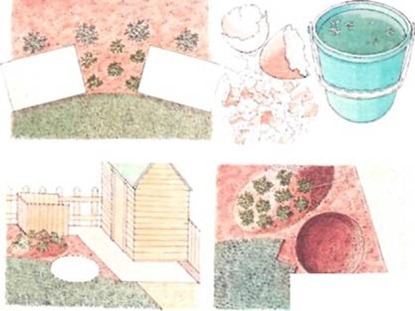





The first plants to go into the cottage garden/perennial area will add to our collection of permanent plants, which started with the gladiolus (corm), the dahlia (tuber) and the Korean chrysanthemum. First choices are periwinkle and thyme, because they are low-growing and spread to carpet the ground, making new plants as they go. We prepare our tree pit but back fill it so nobody falls in by mistake. Easy enough to re-excavate when the tree does arrive.
Needs list: One 1/2 cwt/50 lb bag moss peat; 4 periwinkle plants; 6 thyme plants.
Time budget: 4 hours in 1 week
First hints of autumn tint this week’s weather, with heavy dews and often misty nights. All truly summer plants are over, and autumn flowering ones have not yet reached their best, which is why so many gardens look rather jaded round now. Harvest seeds and fruits, tidy tired plants.
Most of the plants in the early gardens both of Europe and America were herbs or wild flowers, collected from meadows, woods and hedgerows and then cultivated. The periwinkle, Vinca minor, is one such wild flower of Europe brought into cultivation centuries ago. A marvellous plant, with glossy evergreen leaves and green stems that arch and root where they touch the ground, making, in time, large mats that keep the weeds down. Grows anywhere, any soil, sun or shade, and is nearly always in flower. There are forms with leaves variegated silver or gold. Though the flower is usually sky blue, there are forms with white flowers, purple flowers and even double flowers. Chop plants back if they get too big.
1. Keep all containers well watered, also marrows/squashes, tomatoes and other high water content vegetables. Elsewhere use water with restraint: only water when necessary.
2. Trim faded parts of annuals, vines and bedding plants.
3. Work compost from your own heap into the surface of the soil in the gladiolus bed. If the ground is really dry, soak it first.
4. If you have neglected your weeding, go out into your garden and look at your weeds. You’ll find they’re covered in seed pods – all ready to start another crop of weeds for later in the year. Old saying: one year’s seeds make 7 years weeds. Be warned. Weed immediately.
5. Your lawn may be starting to look brown and scorched. It will recover quickly after rain. Only water newly turfed areas. Dry spells keep the moss in check.
6. Learn about a few more friends and foes. Earwigs are especially destructive to dahlias. Loosely fill a peat pot with paper, place on top of stake. Remove paper every few days and burn it, with the insects in it. Renew paper. Bees are friends: just don’t disturb their nest.

If you’ve already got a large tree in your garden, casting dense shade, look on it with affection: it may stop you growing some plants but it’ll help you grow others. Don’t plant close to the trunk, but keep an area under the fringe of the branches for your cottage garden perennial plants. Dig holes 6 in. deep, trim any roots you find with pruning shears/secateurs, and fill holes with soilless growing mix. Plant periwinkle, and others as recommended in Stage 5. Plant thyme between the paving slabs round your lawn. 6 in. hole, soilless growing mix. You know the drill. Space plants 8 in. apart. They’ll grow together. Plant more periwinkle outside the slabs. 6 in. hole, soilless growing mix. Space 12 in. apart. Firm. Soak.
Next, make up your own high nitrogen fertilizer. Crush eggshells from the kitchen, leave them in a plastic bucket of water for 2 weeks or longer. Use the resulting liquid as a liquid feed. Don’t use on acid-loving plants. Next consider your tree and where it will grow. The site was determined earlier on the plan. Check it again. Trees take a lot of planting. If they’re in the wrong place, they take a lot of moving. Stick a rake in the ground, handle end down, to give you some idea what your tree position really means – where the shade falls, what it hides. Mark out hole 3 ft. across: use stake/string/peg method for marking hole (see Stage 8).
Lift turf: see Stage 8. Stack turf for rockery later. Dig hole 18 in. deep. Dig sides straight down. Flat bottom. Break up soil at bottom. Fill back mixing peat with the soil. Surplus soil to rockery/rock garden area. Don’t firm hole. Just let soil settle itself. Later, when you plant the tree, make sure the soil is just below the soil level the tree was growing at before. If you get earth above that the bark will rot and the tree will die. You’ll find that the root/trunk junction is just above ground.
Two Hour Gardening Project: Stage 26 Climbing Plants and Pergolas
Two Hour Gardening Project: Stage 25 Getting To Know Your Garden
Two Hour Gardening Project: Stage 24 Propagation and Growing Herbs
Two Hour Gardening Project: Stage 23 Principles of Pruning
Two Hour Gardening Project: Stage 19 Helleborus Niger and Bug Hunting
Two Hour Gardening Project: Stage 18 Choosing Shrubs for the Garden
Copyright © www.100flowers.win Botanic Garden All Rights Reserved